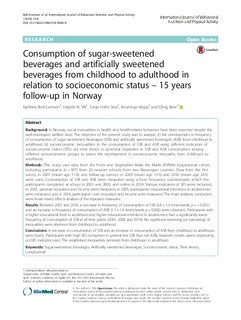| dc.contributor.author | Bolt-Evensen, Kathrine | |
| dc.contributor.author | Vik, Frøydis Nordgård | |
| dc.contributor.author | Stea, Tonje Holte | |
| dc.contributor.author | Klepp, Knut Inge | |
| dc.contributor.author | Bere, Elling | |
| dc.date.accessioned | 2019-04-25T07:42:08Z | |
| dc.date.available | 2019-04-25T07:42:08Z | |
| dc.date.created | 2018-01-31T23:36:23Z | |
| dc.date.issued | 2018 | |
| dc.identifier.citation | International Journal of Behavioral Nutrition and Physical Activity. 2018, 15:8 1-9. | nb_NO |
| dc.identifier.issn | 1479-5868 | |
| dc.identifier.uri | http://hdl.handle.net/11250/2595373 | |
| dc.description.abstract | BACKGROUND: In Norway, social inequalities in health and health-related behaviors have been reported despite the well-developed welfare state. The objective of the present study was to analyze; (i) the development in frequency of consumption of sugar-sweetened beverages (SSB) and artificially sweetened beverages (ASB) from childhood to adulthood; (ii) socioeconomic inequalities in the consumption of SSB and ASB using different indicators of socioeconomic status (SES); (iii) time trends in potential disparities in SSB and ASB consumption among different socioeconomic groups to assess the development in socioeconomic inequality from childhood to adulthood. METHODS: This study uses data from the Fruits and Vegetables Make the Marks (FVMM) longitudinal cohort, including participants (n = 437) from 20 random schools from two Norwegian counties. Data from the first survey in 2001 (mean age 11.8) and follow-up surveys in 2005 (mean age 15.5) and 2016 (mean age 26.5) were used. Consumption of SSB and ASB were measured using a food frequency questionnaire, which the participants completed at school in 2001 and 2005, and online in 2016. Various indicators of SES were included; in 2001, parental education and income were measured, in 2005, participants' educational intentions in adolescence were measured, and in 2016, participants' own education and income were measured. The main analyses conducted were linear mixed effects analysis of the repeated measures. RESULTS: Between 2001 and 2016, a decrease in frequency of consumption of SSB (2.8 v 1.3 times/week; p = < 0.001) and an increase in frequency of consumption of ASB (1.1 v 1.6 times/week; p = 0.002) were observed. Participants with a higher educational level in adulthood and higher educational intentions in adolescence had a significantly lower frequency of consumption of SSB at all time points (2001, 2005 and 2016). No significant widening (or narrowing) of inequalities were observed from childhood to adulthood. CONCLUSIONS: A decrease in consumption of SSB and an increase in consumption of ASB from childhood to adulthood were found. Participants with high SES consumed in general less SSB (but not ASB), however, results varied depending on SES indicator used. The established inequalities persisted from childhood to adulthood. | nb_NO |
| dc.description.abstract | Consumption of sugar-sweetened beverages and artificially sweetened beverages from childhood to adulthood in relation to socioeconomic status - 15 years follow-up in Norway | nb_NO |
| dc.language.iso | eng | nb_NO |
| dc.rights | Navngivelse 4.0 Internasjonal | * |
| dc.rights.uri | http://creativecommons.org/licenses/by/4.0/deed.no | * |
| dc.title | Consumption of sugar-sweetened beverages and artificially sweetened beverages from childhood to adulthood in relation to socioeconomic status - 15 years follow-up in Norway | nb_NO |
| dc.type | Journal article | nb_NO |
| dc.type | Peer reviewed | nb_NO |
| dc.description.version | publishedVersion | nb_NO |
| dc.source.pagenumber | 1-9 | nb_NO |
| dc.source.volume | 15:8 | nb_NO |
| dc.source.journal | International Journal of Behavioral Nutrition and Physical Activity | nb_NO |
| dc.identifier.doi | 10.1186/s12966-018-0646-8 | |
| dc.identifier.cristin | 1560034 | |
| dc.description.localcode | Nivå1 | nb_NO |
| cristin.unitcode | 201,18,2,0 | |
| cristin.unitname | Institutt for folkehelse, idrett og ernæring | |
| cristin.ispublished | true | |
| cristin.fulltext | original | |
| cristin.qualitycode | 2 | |

